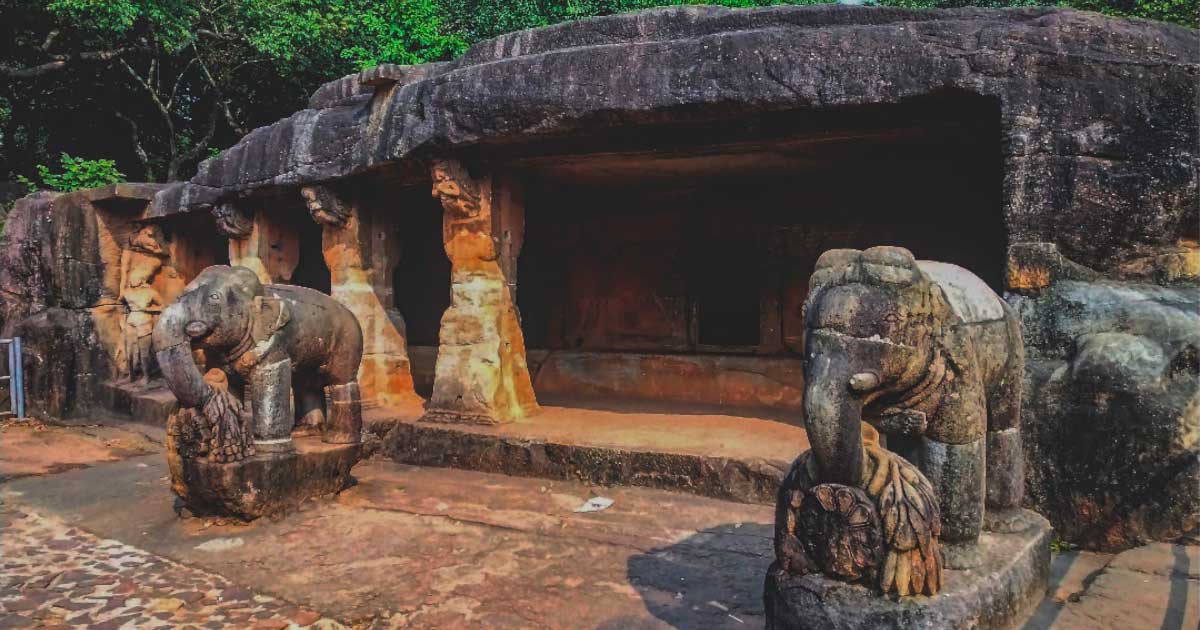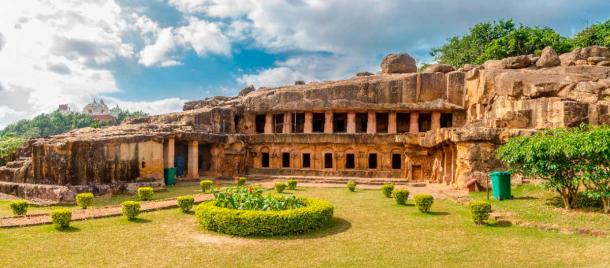Udayagiri and Khandagiri Caves: Intricate Jain Monuments to Faith
There is an incredible archaeological site just outside the city of Bhubaneswar in Odisha, India that attracts thousands of tourists each year. The Udayagiri caves are part natural, part man-made caves that serve as a temple. Nestled in the hills just outside the city, the temples are lavishly decorated with ornate carvings. They date back to the 1st century BC, but even the intricate sculptures have been preserved incredibly well.
The caves are situated on two adjacent hills: Udayagiri and Khandagiri. They were turned into temples during the reign of King Kharavela of the Mahameghavahana dynasty, which ruled the ancient kingdom of Kalinga from the 2nd century BC to the 5th century AD. There are thirty two caves in total which have been transformed into temples. The caves are all Jain temples with the exception of one temple which is dedicated to Hinduism.
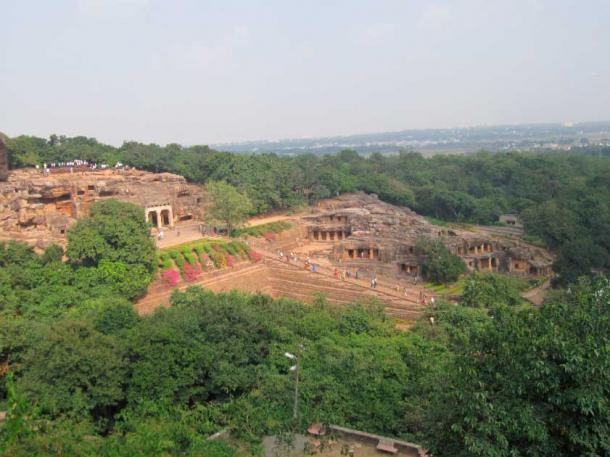
Panaromic view of Udayagiri caves from Khandagiri (Pbedekar / CC BY SA 3.0)
What is Jainism?
Jainism is one of the world’s oldest religions, originating around 2,500 years ago. It is still an integral part of Indian culture and life today, with around 4-5 million followers. Jainism promotes enlightenment through extreme non-violence, encouraging people to reduce harm to living things, including plants and animals, as much as possible. Jainism also has four other vows that practitioners must follow: always speak the truth, show sexual restraint (ideally celibacy), do not steal, and do not become attached to worldly things.
Followers of Jainism worship multiple deities, especially the Jinas. These were spiritual leaders who had achieved enlightenment and therefore escaped the cycle of rebirth. There are 24 of these Jinas, although Jains predominantly worship four: Mahāvīra, Parshvanatha, Neminatha and Rishabhanatha. Jains also worship a number of different gods and goddesses.
The Udayagiri caves and Khandagiri caves were made specifically for Jain ascetics. An ascetic is someone who practices the self-denial of worldly things. This practice usually includes a lack of any possessions, even clothes, as well as fasting, penance, and self-mortification. Ascetics also refrain from any human cravings, such as sex, and practice yoga and meditation. The reason for this is to achieve moksha, or liberation, from the cycle of rebirth. To achieve this, one has to free their soul from any earthly desires. It is for this reason that the caves were made. It provided ascetics a place to worship, meditate, and avoid distractions.
- Mahavira: Abandoning Luxury to Revive Jainism
- The Colossal Jain Gommateshwara Statue is One of the Largest Monolithic Statues in the World
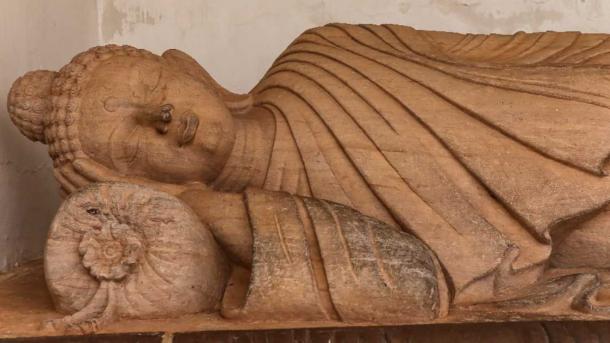
Sculpture in Udayagiri and Khandagiri Caves near the city of Bhubaneswar in Odisha, India (Wirestock Creators / Adobe Stock)
The Astonishing Udayagiri Caves
The Udayagiri cave system features 18 caves. Rani Gumpha, also referred to as cave number one, is the largest, and widely considered to be the most beautiful cave in the complex. It is believed that it was occupied by the Queen of Lalatendu Kesari. This cave is double-storied with 32 cells. Each of these cells is intricately decorated with relief sculptures. Rani Gumpha contains sculptures depicting the victory march of King Kharavela, ‘dwarapala’ or guards of the temple, wild animals and women playing instruments.
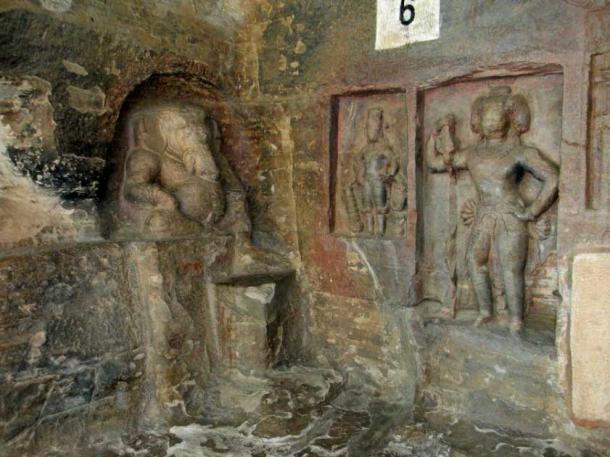
Cave 6 of the Udayagiri Caves, showing a dwarapala guardian, Vishnu, and Ganesh (ZippyMarmalade / CC BY SA 4.0)
Another notable section in the Udayagiri caves is that of Hathi Gumpha. The architecture is not impressive; however, the inscription carved onto the brow of the cave is important. The inscription is the only source of information we have on King Kharavela, who ruled the region when the temples were constructed. The inscription is seventeen lines long and starts with Namokara Mantra, a Jain mantra recited to this day. This is significant, as it gives us confirmation that Jainism was the religion of the time. The inscription then goes on to provide a biographical overview of King Kharavela and his achievements.
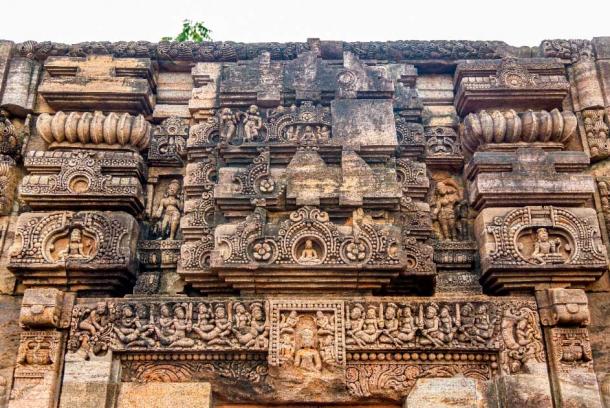
A decorative relief at the Udayagiri Cave Complex, Odisha, India. (Milosk50 / Adobe Stock)
Ganesha Gumpha is another of the important sections of the Udayagiri caves. This cave is named after Ganesha, an important deity who features on the back right cell of this cave. This is one of a few of the caves that had carvings added to them at a later date, during the medieval period. The cave has two large statues of elephants carrying garlands at the entrance, the earliest example of sculpture animals being used as a guard to an entrance. The elephants are each holding branches of a mango tree over a lotus. The same ‘dwara pala’ that feature in the Rani Gumpha cave also feature in this cave. The carvings in this cave also tell the story of the elopement of Bassavadatta, Princess of Ujjayini, with King Udayana of Kausambi.
Some modern scholars are of the opinion that Udayagiri also served as a theater complex. King Kharavela was an enthusiastic patron of culture and the arts, and so it is possible that he had the complex built not just for Jain ascetics but also for public performances.
- Ten Amazing Caves of the Ancient World
- The Wondrous Buddhist Rock-Cut Architecture of the Ajanta Caves
Panoramic view at the Rani Gumpha caves of Udayagiri caves complex in Bhubaneswar, Odisha, India (Milosk50 / Adobe Stock)
The Khandagiri Caves and the dedication of Kharavela
On the opposite hill from Udayagiri is Khandagiri. The Khandagiri cave system is comprised of just 15 caves. These caves are simpler in style than the Udayagiri caves, and feature medieval carvings of the 24 Jain ‘Jinas’, also known as ‘Tirthankaras’. The most notable cave at Khandagiri is cave number 3, known as Ananta Gumpha. It is named after the twin serpents that are caved onto the doors’ arches. The cave features a carving of the goddess Gaja-Lakshmi in a lotus lake, with lotus stalks in her arms. Gaja-Lakshmi is considered a symbol of prosperity in Jainism.
The Udayagiri caves and Khandagiri caves are incredibly significant because they are one of the rare examples of ancient Jain rock-cut caves on the Indian subcontinent. Also of great importance are the inscriptions that confirm Jainism as the religion of the time, and describe how deeply religious King Kharavela was. The inscriptions and sculptures outline how Kharavela lived a life that adhered to the core principles of Jainism, with the complex almost serving as a reminder to his ancestors of his dedication to his religion.
Top image: The entrance to the Ganesha Gumpha section of the Udayagiri cave complex. Source: Paramanu Sarkar / CC BY SA 4.0
By Mark Brophy
References
Haraniya, K. June 15, 2017. Rock Cut Temples of Udayagiri and Khandagiri. Live History India. Available at: https://www.livehistoryindia.com/story/monuments/rock-cut-temples-of-udayagiri-and-khandagiri
Jainism. N.D. National Geographic. Available at: https://education.nationalgeographic.org/resource/jainism
Khandagir and Udayagiri. N.D. Khorda. Available at: https://khordha.nic.in/tourist-place/khandagir-udayagiri/
Rath, J. 2007. Kharavela: The Great Philanthropic Emperor. Orissa Review. Available at: http://magazines.odisha.gov.in/Orissareview/apr-2007/engpdf/page40-41.pdf
















